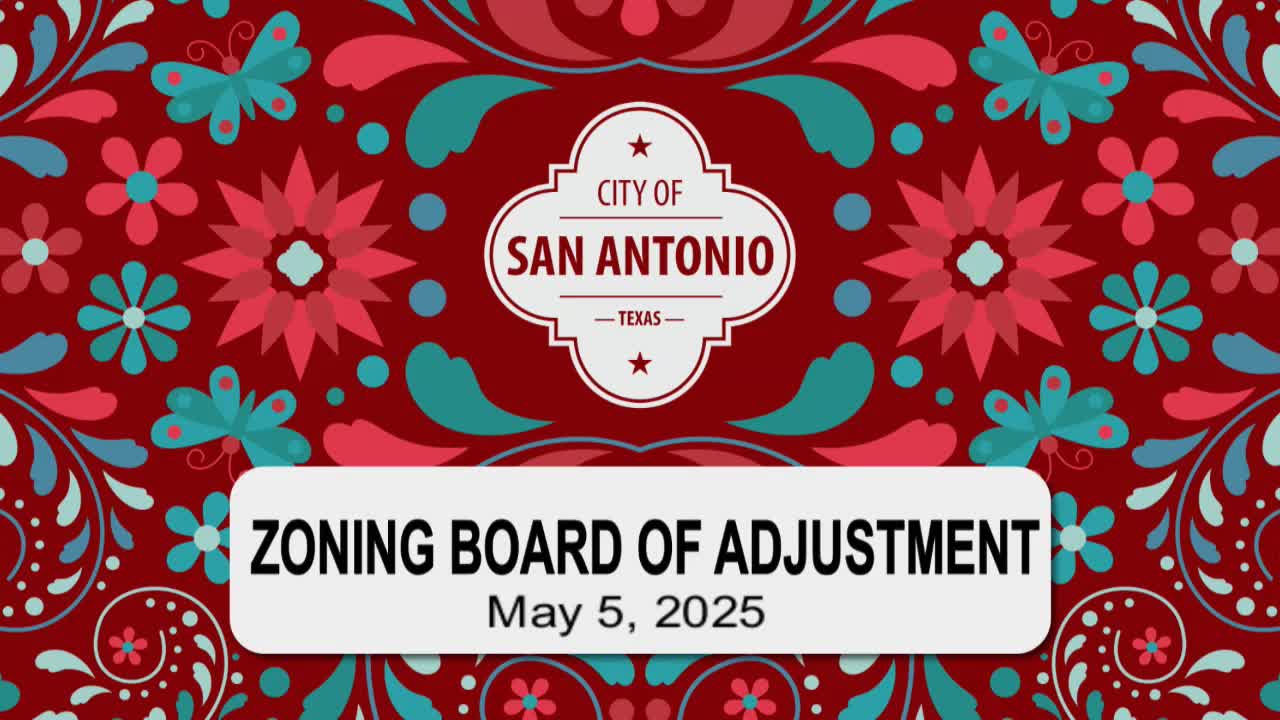San Antonio Board of Adjustments Considers Setback Variance for Estela Bierl's Property
May 05, 2025 | San Antonio, Bexar County, Texas
This article was created by AI summarizing key points discussed. AI makes mistakes, so for full details and context, please refer to the video of the full meeting. Please report any errors so we can fix them. Report an error »

The San Antonio Zoning Board of Adjustment convened on May 5, 2025, to address several key zoning cases, highlighting the ongoing challenges and considerations surrounding local development and community regulations. The meeting began with a formal roll call and an overview of the board's responsibilities, emphasizing its role as an administrative body rather than a judicial one. This distinction is crucial as the board evaluates requests for variances and special exceptions based on established zoning codes.
One of the primary cases discussed involved a request for a two-foot rear setback variance at 714 Chihuahua Street. The applicant, Estela Bierl, sought to reduce the required 20-foot rear setback to 18 feet for a new addition to the property. This case is particularly significant as it is tied to an ongoing code enforcement investigation regarding construction without a permit. The outcome of this case will determine whether the applicant can proceed with the necessary permits for the construction, underscoring the board's critical role in balancing community standards with individual property rights.
The board's procedural framework was also a focal point of the meeting. Each case is presented with a detailed overview, including maps indicating property owner support or opposition. This transparency is vital for maintaining community trust and ensuring that all voices are heard during the decision-making process. The board requires a 75% majority for motions to pass, which adds a layer of complexity to the discussions, especially when full attendance is not guaranteed.
In addition to the setback variance, the board anticipated discussing other cases, including those with recommendations for approval, to maximize the number of affirmative votes. This strategic approach reflects the board's commitment to efficiently managing its agenda while ensuring thorough consideration of each case.
As the meeting progressed, it became clear that the board's decisions have far-reaching implications for the San Antonio community. The outcomes not only affect individual property owners but also shape the broader landscape of zoning regulations and community development. The board's careful deliberation and adherence to established codes are essential in navigating the complexities of urban growth and maintaining the character of neighborhoods.
In conclusion, the San Antonio Zoning Board of Adjustment's meeting on May 5, 2025, highlighted the intricate balance between regulatory compliance and community development. As the board continues to address various cases, the implications of their decisions will resonate throughout the city, influencing future development and community standards. The next steps will involve further deliberation on the presented cases, with the board's decisions expected to reflect both legal requirements and community interests.
One of the primary cases discussed involved a request for a two-foot rear setback variance at 714 Chihuahua Street. The applicant, Estela Bierl, sought to reduce the required 20-foot rear setback to 18 feet for a new addition to the property. This case is particularly significant as it is tied to an ongoing code enforcement investigation regarding construction without a permit. The outcome of this case will determine whether the applicant can proceed with the necessary permits for the construction, underscoring the board's critical role in balancing community standards with individual property rights.
The board's procedural framework was also a focal point of the meeting. Each case is presented with a detailed overview, including maps indicating property owner support or opposition. This transparency is vital for maintaining community trust and ensuring that all voices are heard during the decision-making process. The board requires a 75% majority for motions to pass, which adds a layer of complexity to the discussions, especially when full attendance is not guaranteed.
In addition to the setback variance, the board anticipated discussing other cases, including those with recommendations for approval, to maximize the number of affirmative votes. This strategic approach reflects the board's commitment to efficiently managing its agenda while ensuring thorough consideration of each case.
As the meeting progressed, it became clear that the board's decisions have far-reaching implications for the San Antonio community. The outcomes not only affect individual property owners but also shape the broader landscape of zoning regulations and community development. The board's careful deliberation and adherence to established codes are essential in navigating the complexities of urban growth and maintaining the character of neighborhoods.
In conclusion, the San Antonio Zoning Board of Adjustment's meeting on May 5, 2025, highlighted the intricate balance between regulatory compliance and community development. As the board continues to address various cases, the implications of their decisions will resonate throughout the city, influencing future development and community standards. The next steps will involve further deliberation on the presented cases, with the board's decisions expected to reflect both legal requirements and community interests.
View full meeting
This article is based on a recent meeting—watch the full video and explore the complete transcript for deeper insights into the discussion.
View full meeting
